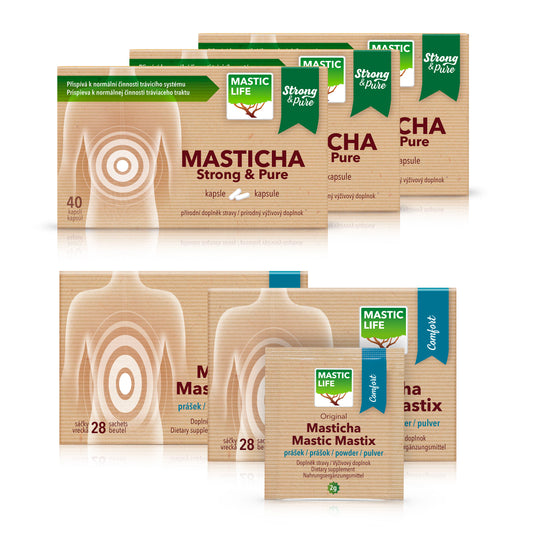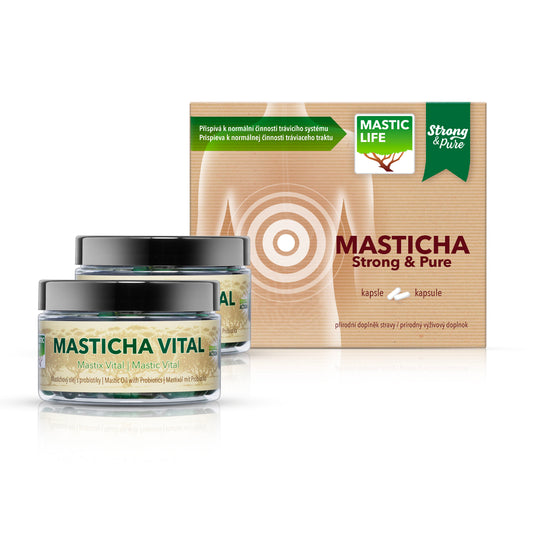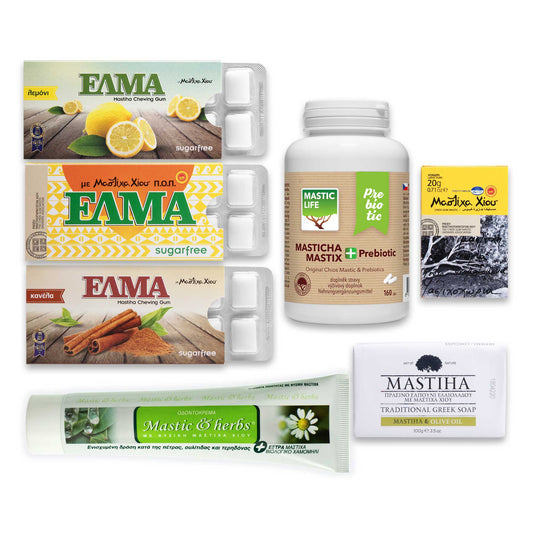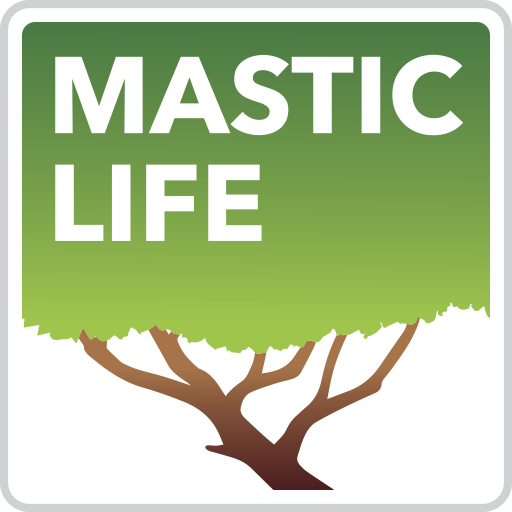Mastichochoria - The Mastic Village of Chios
The Mastichochoria area is a center for the cultivation and processing of mastic gum. Fortified villages were built to protect the production of mastic gum from island conquerors and pirates.
Mastichoria (Μαστιχοχορια)
Mastichoria (Μαστιχοχορια) is the name for the southern region of the Aegean island of Chios, one of the largest Greek island. It is the only region in the world where it is possible to obtain mastic gum, a resin with unique properties, from a mastic tree. The production of mastic gum brought this area not only prosperity, but also the interest of conquerors and pirates.
The state of permanent threat led the current ruler of the island to build defense systems and to create settlements concentrating mastic production in individual areas. The construction of settlements and their protection dates back to Byzantine times, but it flourished during the time of Genoa's rule over the island. Today, despite the damage and catastrophe that the villages have undergone for many centuries, they are still a valuable monument.
Development of Mastic Villages
The Giustiniani family of Genoa, the rulers of Chiu from 1346 to 1566, were well aware of the high value and price of mastic gum and sought from the beginning to gain absolute control over the use of this monopoly product in the best possible way. For this reason, they tried to protect the mastic gum not only from pirate raids, but also from smuggling and uncontrolled growers.
After counting and "nationalizing" all the mastic trees, they established 22 new settlements, named Mastichochoria in places invisible from the sea and built as impregnable fortresses. They thus abolished the former method of cultivation in small villages scattered around the island, which was uncontrollable and it was very difficult to keep track of the harvest.
Architecture of Mastic Villages
The new villages were built according to the Italian architecture of the time, by Latin architects and construction companies and engineers. Local farmers were also obliged to participate in the construction. A rectangular tower and residential houses were built in the center of each settlement, next to each other. The houses were built so that their outer perimeter walls formed a defensive wall and in the corners of this wall were cylindrical turrets with loopholes. The streets were very narrow and many of them were blind, so the attackers could not easily get to the tower, which was the heart of the village. This specific architectural plan, in addition to protecting the village, also served for absolute control over the farmers.
Germata
The houses in the villages are built of stone, with a ground floor and a first floor and are covered by a semicircular dome (so-called germata). Stables and storage areas for agricultural products are usually located on the ground floor, while the actual residence is hidden on the top floor. The open main area is called "pounti" and was used for sunbathing and relaxation.
All lofts were built to the same height so that in case of danger, residents could escape from one house to another. Once the construction work was completed, the lords of Genoa settled in the towers and local farmers were forced to move to the newly built houses. For example, at least 14 old settlements were evacuated and moved to Pyrgi, a town built in the early 15th century in the heart of the Mastichochoria area.
The time of isolation
During the time of the Janovans, and later during the Turkish occupation, the area of the southern part of the island of Chios was limited. No one could enter this area unless there was a really good reason to do so. This isolation allowed the villagers of Mastichochoria to maintain traditional values and customs.
Each village formed its own world. This probably explains why each neighboring village had its own dialect, costumes and customs. The closer the villages are to the capital, the more the differences laugh, but the more remote villages still show differences in dialect. Of all the Mastichochorias, the best preserved are those that were not significantly damaged by the earthquake of 1881. These are the villages: Pyrgi, Mesta, Olimpi and also Vessa, Kalamoti and Elata.
| Village | Characteristic |
|---|---|
| Agios Georgios | Hilltop village with panoramic views of Kampos and the sea. |
| Armolia | Fertile plain, central crossroads for southern villages. |
| Vavili | Small plateau, surrounded by mountains, Byzantine heritage. |
| Vessa | Medieval village with well-preserved main gate and stone houses. |
| Vouno | Castle-like medieval village built on a mountain. |
| Elata | Small medieval village on a steep hill with fortified wall remains. |
| Exo Didima | Tiny village near the Byzantine monastery of Panagia Sikelia. |
| Tholopotami | Founded in the 12th century, with sea views to Asia Minor. |
| Thimiana | Traditional architecture, close to mastic-growing areas. |
| Kalamoti | Historical village with stone houses and central square. |
| Kalimassia | Coastal village with Aegean Sea views and Chian architecture. |
| Kataraktis | Southeastern coastal village with a small harbour. |
| Kini | Seaside village with beaches and traditional architecture. |
| Lithi | Tranquil coastal village with traditional houses. |
| Messa Didima | Historical village with central square and stone houses. |
| Mesta | Medieval village with narrow streets and well-preserved architecture. |
| Mirmigi | Traditional village near mastic-growing areas. |
| Nenita | Village with stone houses, central square, and mastic fields nearby. |
| Neochori | Traditional architecture near mastic-growing regions. |
| Olimpi | Stone houses and central square, close to mastic areas. |
| Pagida | Traditional village near mastic-growing regions. |
| Patrika | Village with stone houses and central square, mastic nearby. |
| Pyrgi | Largest medieval village on Chios with fortress-like architecture and Xysta facades. |
| Flatsia | Traditional village close to mastic-growing areas. |
FAQ: Mastichochoria - The Mastic Village of Chios
What are Mastichochoria?
Mastichochoria are a group of traditional villages on Chios Island known for cultivating the unique Chios mastic resin and preserving medieval architecture.
Why are the mastic villages historically important?
These villages were built as fortified settlements to protect locals and their valuable mastic crops from pirates and invaders, reflecting a unique combination of cultural heritage and agriculture.
How can visitors explore Mastichochoria today?
Visitors can walk through the historic streets, admire medieval architecture, watch mastic cultivation, and visit local museums and churches.

Mastic for your gastrointestinal tract
-
 8-week treatment 🗓️
8-week treatment 🗓️Mastic 8 weeks
Regular price 335,00 zł PLNRegular price419,00 zł PLNSale price 335,00 zł PLNSale -
 60-day treatment 💪
60-day treatment 💪Mastic Gum Extra for 60 days
Regular price 597,00 zł PLNRegular price750,00 zł PLNSale price 597,00 zł PLNSale -
 Gift set 🎁
Gift set 🎁Mastic „Life with Mastic"
Regular price 249,00 zł PLNRegular price273,00 zł PLNSale price 249,00 zł PLNSale -
 Gift set 🌿
Gift set 🌿Mastic „Pure Mastic“
Regular price 129,00 zł PLNRegular price141,00 zł PLNSale price 129,00 zł PLNSale




